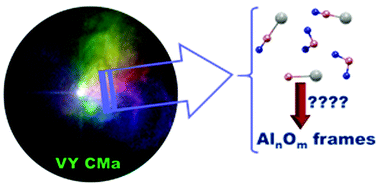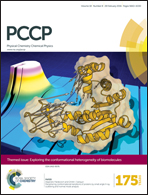Can alumina particles be formed from Al hydroxide in the circumstellar media? A first-principles chemical study†
Abstract
AlOH has been detected in the circumstellar envelope of an oxygen-rich supergiant star (VY CMa) and is an abundant Al-containing system. Water molecules have also been detected, even in a vibrationally excited state. The coalescence of AlOH units and other processes involving AlOH could be the source of alumina-type particles. The results indicate that the formation of (AlOH)2 dimers is barrier-free but (HAlO)2 systems are far more stable. The (AlOH)2 → (HAlO)2 transformation is hindered by substantial energy barriers but is probably moderately fast at very high temperatures. Water catalysis by relay (or Grotthuss-like) mechanisms substantially reduces those barriers to the point that, in the (AlOH)2·(H2O)2 system, the critical transition states lie clearly below 2AlOH + 2H2O. A surface or nucleation environment may favor the (AlOH)2 → (HAlO)2 conversion as to be kinetically competitive with water elimination ((AlOH)2·(H2O)n → (AlOH)2 + nH2O) in the hydrated systems. The hydrated (HAlO)2 structures can easily produce very stable hydrogenated Al2O3 and Al2O4 frames, which, to the same extent, can eliminate molecular hydrogen by exothermic processes. The remaining hydrogen atoms are exterior to the frames and perhaps could be removed by reaction with atomic hydrogen. The possible role of the coalescence of the undetected HAl(OH)2 and Al(OH)2 or AlO2H molecules is discussed. Al(OH)2 can easily be formed by reaction of AlO with a water molecule in exothermic barrier-free processes.


 Please wait while we load your content...
Please wait while we load your content...